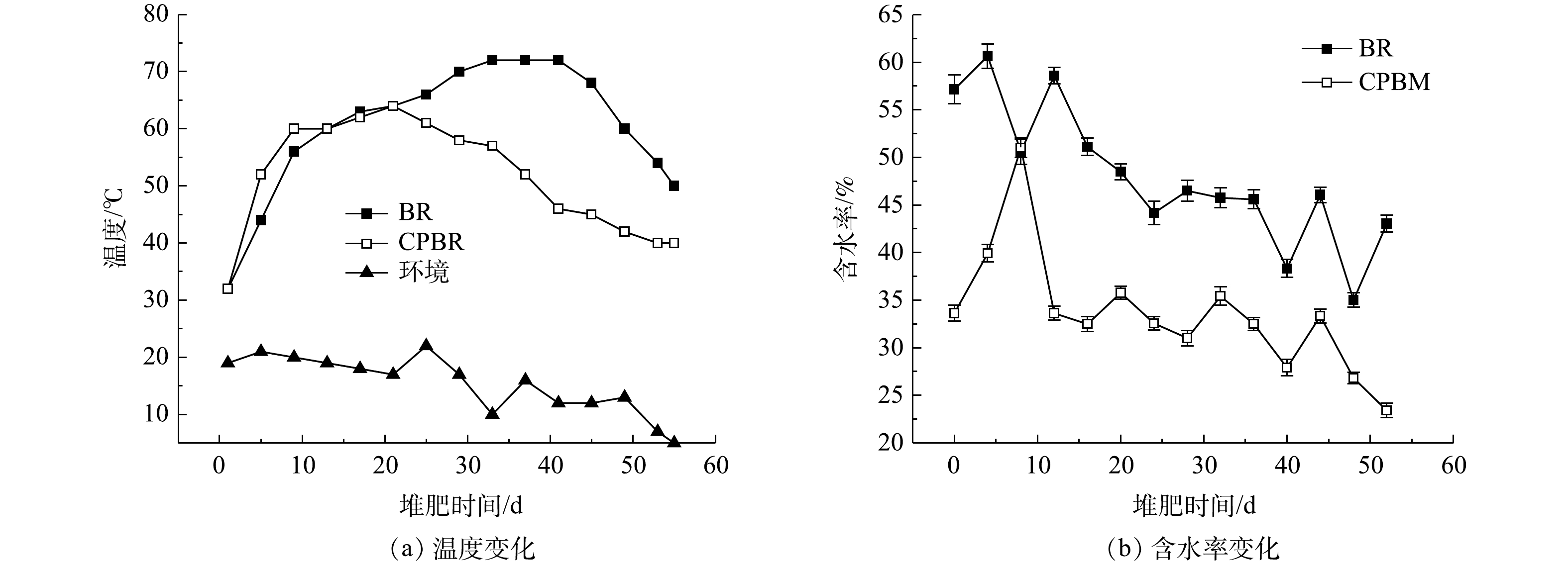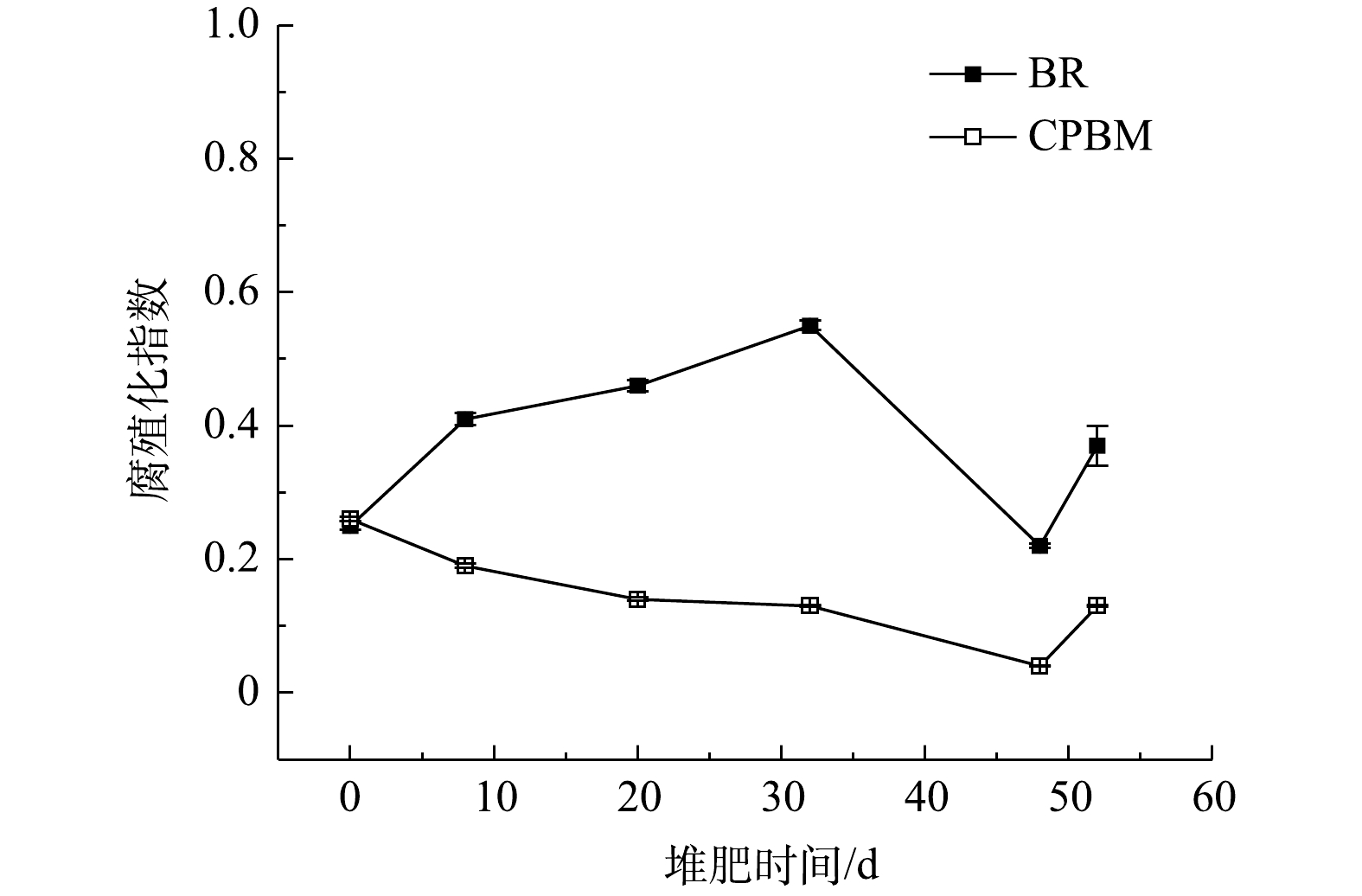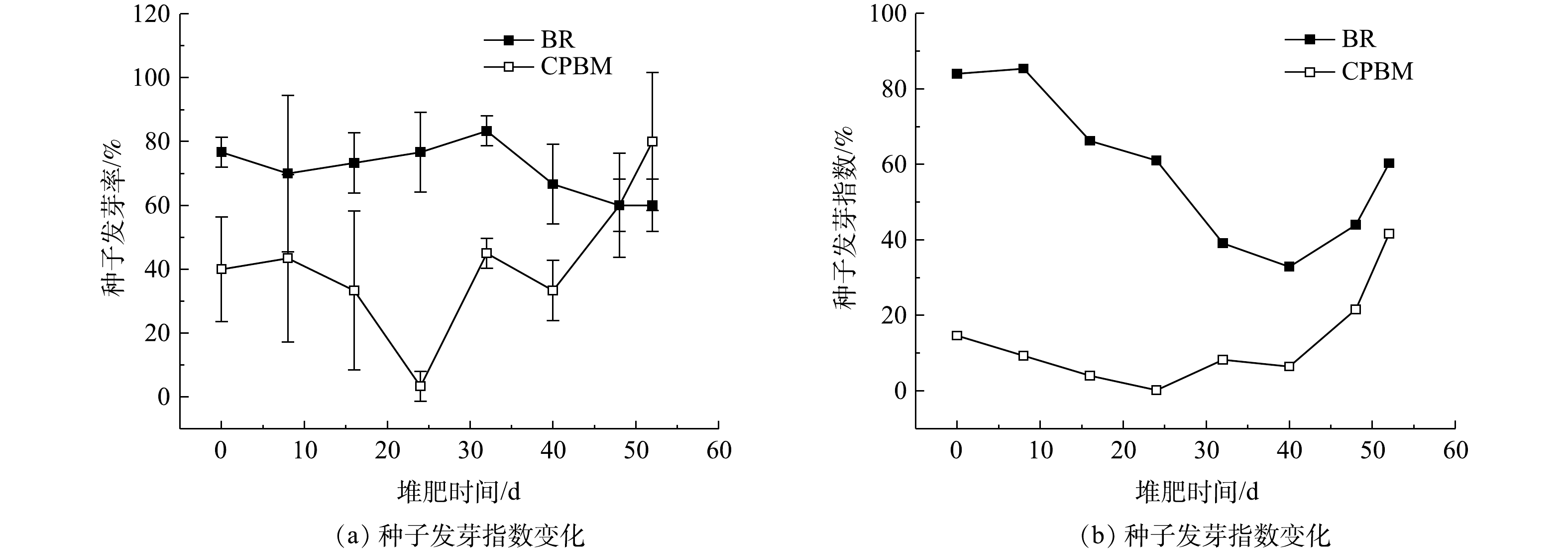-
近年来,我国的垃圾产生量逐年增多[1]。根据生态环境部2016年及2020年的《全国大、中城市固体废物污染环境防治年报》,我国246个大、中城市生活垃圾产量从2015年的18 564.0×104 t增长到2019年的23 560.2×104 t,短短4年增长了27%左右,且处于不断增长的趋势中[2-3]。其中,餐厨垃圾占比最大,约占城市生活垃圾的30%~40%[4]。同时,随着垃圾分类的推进,各省市进一步加大了湿垃圾分类处理的力度,致使原本混在生活垃圾中的厨余垃圾也被分出,从而造成有机易腐垃圾处置量的明显增加。
餐厨垃圾有机质含量高、产量大、产地分散,且极易腐败发酸发臭、滋生有害生物;若在收集转运过程中发生泄漏则会污染空气、土壤及水源,最终会严重干扰人群的正常生活,具有污染属性[5]。同时,餐厨垃圾可用于生产有机酸类、醇类、脂肪酸酯类产品[6],因而具有一定的资源属性[7]。
常见餐厨垃圾资源化技术包括好氧堆肥和厌氧消化等[8]。对于大规模厌氧消化工艺来说,其资源化衍生品主要为油脂、沼气、沼液和沼渣。油脂分离后可加工为工业油,沼气可作为能源利用,而沼液可经过生化及物化深度处理后达标排放,三者处理处置与资源化工艺均已成熟[9-10]。然而,沼渣处理处置与资源化已成为目前面临的主要问题。按照湿垃圾处理工艺模式,每100 t湿垃圾经厌氧消化处理后,将产生20~30 t含水率60%~70%的沼渣。沼渣中含有丰富的磷、钾、镁等营养元素,以及一定量未充分降解的有机物,可作为堆肥原料进行腐殖化[11],其产品可作为肥料应用于园林绿化和农作物用肥。目前,沼渣的堆肥研究包括不同原料和添加物对堆肥效果的影响、堆肥过程中的理化性质变化、堆肥工艺优化等[12],这些研究大多数为小试,与实际工程工况有一定出入。另一方面,餐厨垃圾好氧堆肥也主要集中在分散小型生化处理机,其工艺原理是将菌剂掺进垃圾中,搅拌使分解垃圾的细菌活化,数小时后有机质被分解为水和二氧化碳,以及一次发酵产品。由于分散小型生化机处理时间短,其产品腐熟度不高,致使可能存在的病原微生物无法彻底杀灭,如果直接施用于土壤可能会导致植被烧苗或生蛀虫[13]。
为提升餐厨垃圾资源化衍生品再利用效率,本研究以餐厨垃圾资源化衍生品沼渣(Biogas residue, BR)及生化机出料(Composting products from biochemical machine, CPBM)为堆肥原料,以菌菇渣作为辅料,进行5 t堆肥量级的中试实验。通过分析衍生物在实际工程规模好氧堆肥过程中理化性质及腐熟度等指标的变化,以评价堆肥产品作为绿化种植土及有机肥料的可行性。本研究成果可为餐厨垃圾及湿垃圾衍生品深度腐熟、高效资源化提供参考。
全文HTML
-
消化残渣来自上海松江某餐厨垃圾厌氧消化厂,经离心脱水后得到BR产物;CPBM来自松江某餐厨垃圾堆肥点生化机处理7 d后得到的发酵产物;辅料菌菇渣为食用菌菇废弃物。堆肥体系初始物料的基本性质如表1所示。
-
在堆肥中试中,BR和CPBM均为5 t,与菌菇渣以1∶1的比例混合。中试在上海青浦某堆肥厂露天进行,采用条垛式堆肥技术,堆体宽度、高度分别为2.5、1.0 m。
每3 d进行1次翻堆,翻堆前取样。取样规则为:分别在堆体的上中下不同位置取样并充分混合,每次共取样500 g,样品如不能及时检测均放置在1~2 ℃冰箱冷藏区内进行保存;堆肥时间共计52 d。堆肥现场如图1所示。
-
使用水银温度计插入堆体内部,于每日固定时间测量堆体温度;采用差重法[14] 测定堆体含水率;pH和有机质含量分别采用pH计(pHS-25型,上海精密科学仪器有限公司)和马弗炉(HR-F-1000,洛阳华熔窑炉有限公司)进行测定,具体步骤参照文献[15];采用建磷酸钠浸提法检测腐殖酸含量,具体步骤参照文献[16];采用碱性过硫酸钾消解紫外分光光度法检测腐殖质氮含量,具体步骤参照文献[17];以种子发芽指数(GI)测定采用萝卜种子发芽实验法[18];重金属含量采用原子吸收光谱仪测定,及具体步骤参照文献[19]。
1.1. 供试原料
1.2. 实验方法
1.3. 分析方法
-
对堆肥进程产生影响的因素包括堆肥温度、堆体含水率等[20]。堆肥温度变化可以分为4个阶段:升温阶段、高温阶段、降温阶段和腐熟阶段[21];堆体含水率会随着堆肥时间的增加而不断降低。堆体温度是堆肥化反应进程的直观表现[22],由图2(a)中可以看出,BR和CPBM两堆体体系温度变化趋势基本相同,都呈现先上升后下降的趋势。CPBM体系最高温度上升至60 ℃以上,出现在堆肥20 d,之后温度呈现下降趋势,且在50 d以后逐渐稳定在45 ℃左右。BR堆肥体系最高温度达到70 ℃以上,明显高于CPBM堆肥体系,且最高温度出现时间相对较晚,在40 d左右,这可能是因为BR体系初始含水率较高故导致系统最高温度出现时间较慢的现象。此外,与CPBM相比,BR堆肥体系高温维持时间较长,这可能因为BR体系中含有多样性的功能性嗜热细菌,使其更长高温成为可能[23],腐殖化过程生物反应强度和持续时间均大于CPBM。总体来看,两堆肥体系超过50 ℃的高温期均维持在10 d以上,达到了腐熟及无害化要求[24]。
水分可以溶解堆肥物料中营养物质等,以利于微生物的代谢,而且水分蒸发散热对堆体温度具有一定的调节作用,其含量是影响好氧堆肥效果的关键因素之一[25]。BR与CPBM初始含水率分别为60.45%和17.80%,经菌菇渣调节后,初始堆肥体系含水率分别为57.16%和33.64%。如图2(b)所示,经50 d堆肥后,由于堆体温度升高及微生物的代谢作用,含水率整体呈现下降趋势。尤其是初始含水率较高的BR体系,与初始值相比,含水率下降了14.12%。相关性分析结果表明,两种原料的含水率与堆肥时间的相关性显著(P<0.05),均为负相关,即随着堆肥时间的增加,含水率在不断减少。
-
pH不仅是影响堆肥过程中微生物生产繁殖的主要因素,同时也是反映堆肥进程和衡量堆肥腐熟质量的重要参数。适宜的pH能有效提高微生物活性,充分发挥其降解有机质能力并加快堆肥进程[26]。如图3(a)所示,BR堆肥体系中pH随堆肥时间的增加先稳定在6.5左右而后上升至8.4左右;CPBM堆肥体系则先上升至8.4,又逐步稳定在7.5~8.5。将pH变化图与温度变化图对比可以看出,pH呈现“跃迁”的时间节点与初次出现较高温度的时间节点一致。随着堆肥进行,高温阶段到来,生物代谢活动异常剧烈,堆体中蛋白质的脱氨基释放了大量的NH3使得pH上升,堆体达到了微碱性的环境[24, 27],导致pH由6.55跃迁至8.37。在BR体系中,由于含有的蛋白质类物质较低,前期pH变化不明显;30 d后,堆体温度达到60 ℃以上,生物反应剧烈,随着菌菇渣和微生物菌体的分解,体系中氨含量逐渐增加,导致pH的升高。
如图3(b)所示,两体系中有机质含量呈现缓慢下降趋势,相比于初始含量,BR体系有机质下降了2.72%,CPBM体系有机质下降了8.78%。由此可见,初始垃圾中含有大量的有机物,但其中多数组分不稳定而极易腐败分解,堆肥处理正是将其稳定化的生物转化过程。从有机物含量变化的角度来看,CPBM体系堆肥过程要优于BR体系,表现为堆肥进程较快,这与堆肥原料有机质含量有一定关系。统计分析结果表明,两种原料的有机质含量均与堆肥时间的相关性显著(P<0.05),呈现负相关。
-
1)腐殖化指数。腐殖酸主要由胡敏酸(humic acid, HA)和富里酸(fulvic acid, FA)组成,随着堆肥时间延长,二者的含量发生变化,表现为HA含量增加、FA含量下降。腐殖化程度可以用腐殖化指数(HI=HA/FA)来表示,是决定堆肥质量及腐熟度的重要因素之一[28-29]。如图4所示,CPBM体系HI呈现先下降后上升的趋势,总体变化幅度不大,稳定在0.1~0.3之间;而BR体系的HI变化幅度相对较大,呈现上下波动,总体为上升趋势,这与堆肥的一般规律相同。两种体系腐殖化指数与堆肥时间没有显著相关性,这可能是由于在实验开始阶段,两种原料的HI已经达到较高数值,后续变化也与实验环境不断变化有一定关系。在沼渣的数据分析中,HI与有机质含量相关性显著(P<0.05),呈现负相关性,这说明在堆肥过程中随着有机质的不断减少,BR体系的HI呈现上升趋势。
2)种子发芽指数与种子发芽率。种子发芽指数用来评价堆肥产品的腐熟度。一般认为,种子发芽指数(Germination Index, GI)大于50%即表示堆肥产品已达到腐熟。除此之外,也可用GI来检测堆肥对植物有无毒性,如果GI>50%,认为基本无毒性;当GI达到80%~85%,这种堆肥就可以认为对植物没有毒性[29]。根据图5(a)可以看出,CPBM体系在10 d之后种子发芽率呈现明显下降趋势,这可能是由于堆肥过程中盐分积累和C/N失衡。随着堆肥时间增加,发芽率在40 d之后呈现快速上升趋势,最终达到80%以上,相应GI也超过45%(图5(b))。相比之下,BR体系种子发芽率稳定在60%~85%。在0~30 d的堆肥时间内,两种堆料的种子发芽指数均呈现先下降后上升的趋势,这是由于堆肥过程中产生较多铵盐和有机酸、醛类物质,这些物质对种子发芽产生抑制作用[30]。40 d之后随着温度的降低,铵盐和有机物浓度降低,种子发芽指数逐渐升高。
-
检测两种堆肥成品的养分及有害物质,将所测数据结果与《有机肥料(NY 525-2012)》[18]标准对比分析,如表2所示。最终得到的堆肥产物均为灰褐色,呈粒装和粉状,无恶臭,无机械杂质。
土壤有机质、氮和磷是土壤肥力的重要保障[31]。CPBM最终堆肥成品的磷、钾指标均小于沼渣堆肥成品,总氮则高于BR体系,总养分则低于BR体系。尽管氮含量在堆肥过程中由于生物反应大量损失,有机氮不断生成NH3挥发[32],最终得到的总养分含量仍然满足有机肥标准。CPBM体系的含油量和含盐量分别为BR体系的21.1倍、2.5倍,这也是CPBM体系种子发芽指数偏低的原因之一。蛔虫卵死亡率均为100%,粪大肠菌群数每克不超过5个,这说明高温的杀菌效果显著。BR体系成品堆肥含水率高于标准,主要由于原始含水率较高。因此,可以通过调节BR体系初始含水率、添加辅料和增加堆肥时间以满足有机肥料对于含水率、有机质的要求,其余参数均达到标准要求。
在土壤中施用有机肥料并产生最终稳定的产品,该产品可用于改善和维持土壤质量和肥力[33-34],对于受污染的土壤进行土壤修复具有重要意义,是最具成本效益的土壤修复方法之一[35]。与商品有机肥进行对比发现,商品有机肥的全磷、全钾含量平均值为3.37%、1.79%,分别是BR体系堆肥产品的0.93和1.12倍、CPBM体系的1.53倍和1.52倍。两堆肥体系pH均在5.5~8.5,总体呈微碱性,与商品肥相差不大,重金属含量均未超标[36]。由此可知,餐厨垃圾资源化衍生品经深度腐熟后,可改良土壤性能。
2.1. 温度与含水率随堆肥时间的变化
2.2. pH与有机质含量随堆肥时间的变化
2.3. 腐熟度指标随堆肥时间变化
2.4. 堆肥产品性能
-
1)以CPBM及BR作为原料进行好氧堆肥,在不添加菌剂的情况下,其腐殖化指数均达到0.1~0.4,CPBM体系的种子发芽指数增加了184.7%,BR体系的种子发芽指数则减少了28.3%,最终GI均大于40%;相比于初始含量,BR体系有机质下降了2.72%,CPBM体系有机质下降了8.78%。
2)将pH变化图与温度变化图进行对比,pH呈现“跃迁”的时间节点与初次出现较高温度的时间节点一致,且含水率较高的BR升温至最高点比CPBM晚了16 d,稳定化过程时间较长。
3)餐厨垃圾及其衍生物得到的最终堆肥产品,在使用辅料调节其初始含水率在50%左右的条件下,经过50 d左右的堆肥可以达到《有机肥料(NY 525-2012)》标准要求进入农田使用,对土壤具有一定的改良作用。




 下载:
下载:






